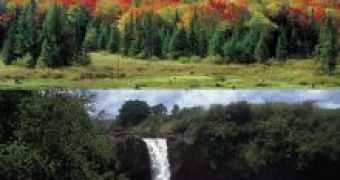The idea that forests are efficient against global warming by absorbing carbon dioxide and releasing water through their leaves is not entirely true, researchers claim.
This is due to the fact that forests absorb sunlight, warming the air in the process.
According to a new study from the Carnegie Institution, planting forests at certain latitudes could make the Earth warmer.
New climate modeling shows that northern temperate forests (top) may contribute to global warming, while tropical forests (bottom) can help keep global temperatures cool.
Complex climate modeling software was used to simulate the changes of the global climate when a large surface of the land was covered with forests, and the results were surprising.
"We were hoping to find that growing forests in the United States would help slow global warming. But if we are not careful, growing forests could make global warming even worse," Ken Caldeira, author of the study, said.
The researchers found that while tropical forests help keep Earth cool by evaporating a great deal of water, northern forests tend to warm the Earth because they absorb a lot of sunlight without losing much moisture.
In one simulation, the researchers covered much of the northern hemisphere (above 20? latitude) with forests and saw a jump in surface air temperature of more than 6? F.
"I like forests. They provide good habitats for plants and animals, and tropical forests are good for climate, so we should be particularly careful to preserve them," Caldeira commented. "But in terms of climate change, we should focus our efforts on things that can really make a difference, like improving efficiency and developing new sources of clean energy."

 14 DAY TRIAL //
14 DAY TRIAL //